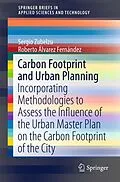This book analyzes the relationship between urban development, greenhouse gases and the carbon footprint, and presents the main preventive measures that can be implemented at the design stage. Readers are provided with the knowledge needed to devise a strategy for calculating the carbon footprint of urban planning instruments, as well as a framework for integrating sustainability into the planning phase. Highlighting the importance of preventive and corrective measures, the book includes practical suggestions on how to meet sustainability requirements in urban planning designs, exploring undeveloped land reserves, urban-project design and infrastructure design, and offers a springboard for further research.
Autorentext
Zusammenfassung
This book analyzes the relationship between urbandevelopment, greenhouse gases and the carbon footprint, and presents the mainpreventive measures that can be implemented at the design stage. Readers areprovided with the knowledge needed to devise a strategy for calculating thecarbon footprint of urban planning instruments, as well as a framework forintegrating sustainability into the planning phase. Highlighting the importanceof preventive and corrective measures, the book includes practical suggestionson how to meet sustainability requirements in urban planning designs, exploringundeveloped land reserves, urban-project design and infrastructure design, andoffers a springboard for further research.
Inhalt
1 Introduction: Importance of Urban Planning Carbon footprint.- 2.1 Sustainability strategic objectives.- 2.2 General methodology.- 2.3 Emission sources.- 2.4 Emission factors.- 2.5 Calculation method.- 3 Carbon footprint calculation method.- 3.1 Greenhouse gas sources.- 3.1.1 Residential.- 3.1.2 Industrial.- 3.1.3 Commercial.- 3.1.4 Public facilities.- 3.2 Concept of carbon footprint.- 3.3 Calculation of carbon footprint.- 3.3.1 Selection of GHGs.- 3.3.2 Setting boundary.- 3.3.4 Footprint calculation examples.- 4 Preventive and corrective measures and metrics.- 3 Social benefits of urban planning carbon footprint evaluation.- 5 Conclusions and future recommendations.
